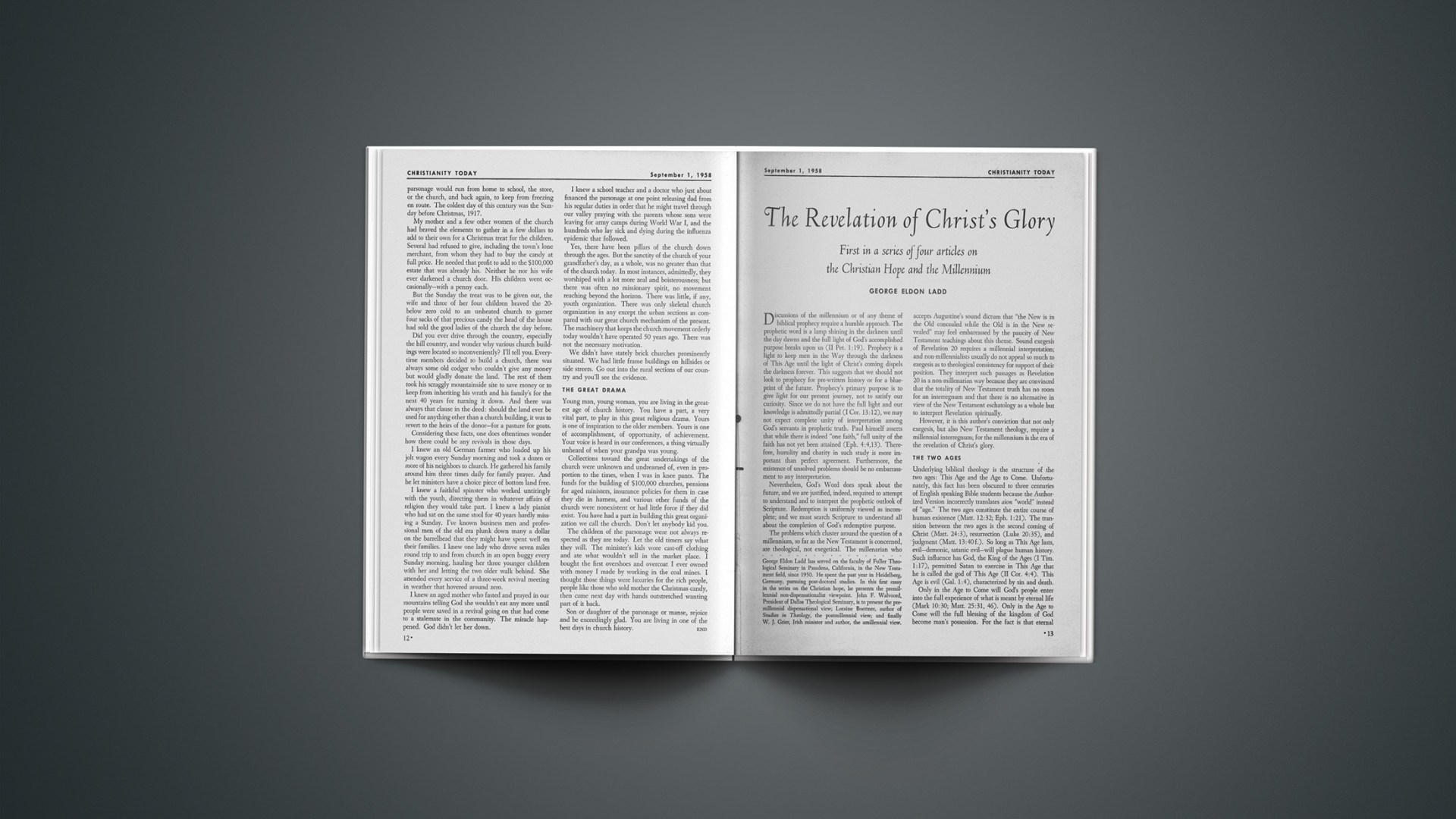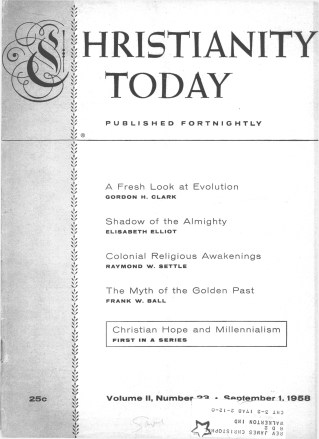First in a series of four articles on the Christian Hope and the Millennium
Discussions of the millennium or of any theme of biblical prophecy require a humble approach. The prophetic word is a lamp shining in the darkness until the day dawns and the full light of God’s accomplished purpose breaks upon us (2 Pet. 1:19). Prophecy is a light to keep men in the Way through the darkness of This Age until the light of Christ’s coming dispels the darkness forever. This suggests that we should not look to prophecy for pre-written history or for a blueprint of the future. Prophecy’s primary purpose is to give light for our present journey, not to satisfy our curiosity. Since we do not have the full light and our knowledge is admittedly partial (1 Cor. 13:12), we may not expect complete unity of interpretation among God’s servants in prophetic truth. Paul himself asserts that while there is indeed “one faith,” full unity of the faith has not yet been attained (Eph. 4:4, 13). Therefore, humility and charity in such study is more important than perfect agreement. Furthermore, the existence of unsolved problems should be no embarrassment to any interpretation.
Nevertheless, God’s Word does speak about the future, and we are justified, indeed, required to attempt to understand and to interpret the prophetic outlook of Scripture. Redemption is uniformly viewed as incomplete; and we must search Scripture to understand all about the completion of God’s redemptive purpose.
The problems which cluster around the question of a millennium, so far as the New Testament is concerned, are theological, not exegetical. The millenarian who accepts Augustine’s sound dictum that “the New is in the Old concealed while the Old is in the New revealed” may feel embarrassed by the paucity of New Testament teachings about this theme. Sound exegesis of Revelation 20 requires a millennial interpretation; and non-millennialists usually do not appeal so much to exegesis as to theological consistency for support of their position. They interpret such passages as Revelation 20 in a non-millenarian way because they are convinced that the totality of New Testament truth has no room for an interregnum and that there is no alternative in view of the New Testament eschatology as a whole but to interpret Revelation spiritually.
However, it is this author’s conviction that not only exegesis, but also New Testament theology, require a millennial interregnum; for the millennium is the era of the revelation of Christ’s glory.
The Two Ages
Underlying biblical theology is the structure of the two ages: This Age and the Age to Come. Unfortunately, this fact has been obscured to three centuries of English speaking Bible students because the Authorized Version incorrectly translates aion “world” instead of “age.” The two ages constitute the entire course of human existence (Matt. 12:32; Eph. 1:21). The transition between the two ages is the second coming of Christ (Matt. 24:3), resurrection (Luke 20:35), and judgment (Matt. 13:40f.). So long as This Age lasts, evil—demonic, satanic evil—will plague human history. Such influence has God, the King of the Ages (1 Tim. 1:17), permitted Satan to exercise in This Age that he is called the god of This Age (2 Cor. 4:4). This Age is evil (Gal. 1:4), characterized by sin and death.
Only in the Age to Come will God’s people enter into the full experience of what is meant by eternal life (Mark 10:30; Matt. 25:31, 46). Only in the Age to Come will the full blessing of the kingdom of God become man’s possession. For the fact is that eternal life and the kingdom of God (Mark 10:24f.) both belong to the Age to Come, not to This Age.
On the basis of this so-called antithetical structure of the two ages, it can be argued that there is no room for an interregnum between This Age and the Age to Come. The New Testament, it is said, makes the second coming of Christ the dividing point between the ages. At his coming, we shall enter into the full enjoyment of the redemptive blessings of eternal life and the kingdom of God. The coming of Christ is the center of the New Testament expectation of the future. God’s purposes will then be consummated; the Age to Come will then begin.
Facing The Difficulties
The difficulty with this apparently persuasive reasoning is that it proves too much; for in this same antithetical structure, both eternal life and the kingdom of God are exclusively future, not a present possession. Yet every Sunday School child knows that Jesus came to give men eternal life here and now; for he who believes on the Son has eternal life (John 3:36). Furthermore, the kingdom of God is something present which men enter by the new birth (John 3:3, 5); the redeemed are already in the kingdom of God’s Son (Col. 1:13).
Long ago, Professor Geerhardus Vos pointed out in his Pauline Eschatology that the great themes of redemption-justification, the Holy Spirit, as well as eternal life and the kingdom of God—are “semi-eschatological” realities. That is, although they belong to the Age to Come, they have entered into human history through the incarnation and redemptive work of Christ. The redeemed man experiences in This Age, evil as it is, a bit of the life of the Age to Come. There is, in other words, an overlapping of the ages. The redeemed live “between the times”—in two ages at once. We may taste of the powers of the coming age (Heb. 6:5) and thereby be delivered from this present evil age (Gal. 1:4), no longer being conformed to it even though we live in it (Rom. 12:2).
Professor Vos correctly sketches this relationship by two overlapping lines on different levels. Therefore, although the Age to Come is future and begins with the coming of Christ in glory, this new age has already begun with the Incarnation—the coming of Christ in humility. The two ages have come together. However, it is important to note that many passages of Scripture make no reference to this fact. The Age to Come is usually viewed as altogether future, even though it is “spiritually” present.
The millennium is a further stage in this overlapping of the ages. The Age to Come, which is now working secretly in This Age within the lives of God’s people, will manifest itself in outward glory before the final inauguration of the Age to Come. The life of the Age to Come will show itself more splendidly in this world before the final judgment falls and God brings the new heavens and the new earth.
Theological Necessity
The theological necessity for such a period is seen in 1 Corinthians 15:23–28. In the days of his flesh, Christ emptied himself, pouring himself out in humility even to the point of death. “But made himself of no reputation, and took upon him the form of a servant, and was made in the likeness of men: And being found in fashion as a man, he humbled himself, and became obedient unto death, even the death of the cross” (Phil. 2:7–8). He is now exalted “Wherefore God also hath highly exalted him, and given him a name which is above every name,” (Phil. 2:9) and seated at the right hand of God; but his glory does not appear to the world. This Age is still the evil age. Christ’s glory is known only to his people, but even they suffer and die. Christ’s rule is hidden from the world. He is indeed now reigning in victory and enthroned with his Father (Rev. 3:21); but the world does not know it, for his reign has not been disclosed to the world. In fact, so far as the world is concerned, his reign is in a sense potential and not realized. “As it is, we do not yet see everything in subjection to him” (Heb. 2:8, RSV).
Yet, “he must reign until he has put all his enemies under his feet” (1 Cor. 15:25). His reign must become public in power and glory. The “reign of grace” must become a “reign of power.”
The Age To Come
However, the Age to Come is not the age of Christ’s reign; it is the age of the Father’s glory. First Corinthians 15:21–24 designates three stages in God’s redemptive purpose. First is the resurrection of Christ, the first fruits of the resurrection (vv. 21, 23). Then will occur the resurrection of those who are Christ’s at his coming. “After that (the literal meaning of the Greek particle) comes the end, when he delivers the kingdom to God the Father” (v. 24). Here is the third stage, which is the Age to Come. Then, “the Son himself will also be subjected to him who put all things under him, that God may be all in all” (vs. 28).
The Age to Come after “The End” is the age of the Father’s all-encompassing dominion. The Church age—the era between the Resurrection and the Parousia—is the age of the Son’s hidden rule. The millennium will be the age of the manifestation of Christ’s glory when the sovereignty, which he now possesses but does not manifest, and which he will give over to the Father in the Age to Come, will be manifested in glory in the world. God yet has a glorious destiny for the race which will be accomplished by the Son when he comes to reign in glory.
George Eldon Ladd has served on the faculty of Fuller Theological Seminary in Pasadena, California, in the New Testament field, since 1950. He spent the past year in Heidelberg, Germany, pursuing post-doctoral studies. In this first essay in the series on the Christian hope, he presents the premillennial non-dispensationalist viewpoint. John F. Walvoord, President of Dallas Theological Seminary, is to present the premillennial dispensational view; Loraine Boettner, author of Studies in Theology, the postmillennial view; and finally W. J. Grier, Irish minister and author, the amillennial view.










